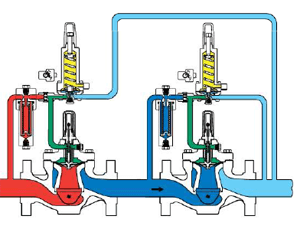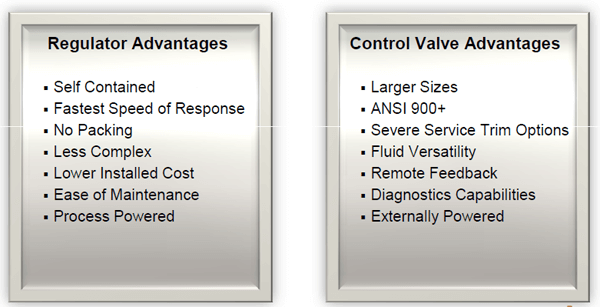Keith Erskine with Emerson local business partner Puffer-Sweiven and Vince Mezzano with Fluor co-presented a look at considerations in selecting control valves versus regulators. Their abstract:
This session will review the selection criteria for consideration of pressure regulators vs. control valves for uses on various applications to ensure the best technical and cost-effective solutions. Understanding unique application requirements and the full capabilities of each product type leads to the optimal selection and minimal rework to for the best technical as well as economical solution. Applications reviewed include tank blanketing, cavitating liquids, differential pressure control, and backpressure control, covering upstream, downstream, and various process industries.
They opened comparing regulators versus control valves:
Regulators serve the purpose of matching the flow demand while maintaining a constant pressure. It performs the function of valve, actuator, controller and pressure transmitters in one device. Functions it performs include pressure reduction, backpressure / release and differential control. While a control valve is powered by the control loop, a regulator is powered by the process.
Keith described different types of regulators including self-operated regulators, pilot-operated regulators and control valves. Pilot operated regulators have greater accuracy in regulating pressure and greater capacity if an application requires it. With a control valve there is no droop in pressure and the downstream pressure remains constant across the range of flow rates. Control valves can have their pressure setpoints changed remotely by the control system.
Five applications where you may want to compare the use of regulators versus control valves include blanket gas control, plant feed gas supply, severe service, differential pressure control, and boiler fuel gas. For the tank blanketing application, they shared an example of nitrogen blanketing maintaining pressure between 14 and 20 inches water column (w.c.) For fast automatic response where no diagnostics required back for the control system a regulator works well. For high pressure vessels such as oil & gas production separators, control valves better handle the pressure requirements.
 For the plant feed gas supply application, they provided a scenario where inlet gas pressure is 350psig and downstream is controlled at 75psig and cannot exceed 85psig. They describe monitor regulators placed in series where a second regulator is used to handle plugging or other event which could cause a loss of pressure regulation. The second regulator takes over pressure regulation.
For the plant feed gas supply application, they provided a scenario where inlet gas pressure is 350psig and downstream is controlled at 75psig and cannot exceed 85psig. They describe monitor regulators placed in series where a second regulator is used to handle plugging or other event which could cause a loss of pressure regulation. The second regulator takes over pressure regulation.
The third example was cooling water pressure control. The requirement is to maintain constant pressure on downstream cooling water for 300 psig water, downstream pressure to be controlled at 10 psig, critical to maintain pressure, cavitation predicted for homogenous fluid and 290 psig.
A control valves offer trim designs to eliminate the damaging effects of cavitation, and limit damage from flashing liquids.
You can connect and interact with other valve and regulator experts in the Valves, Actuators & Regulators track of the Emerson Exchange 365 community.





